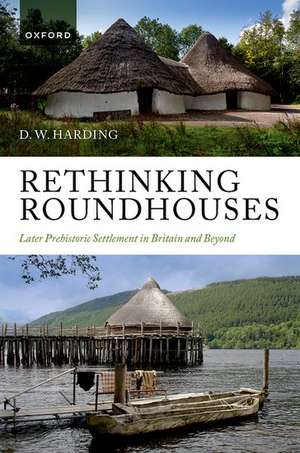Rethinking Roundhouses: Later Prehistoric Settlement in Britain and Beyond
Autor D. W. Hardingen Limba Engleză Hardback – 26 ian 2023
Preț: 582.93 lei
Preț vechi: 775.01 lei
-25% Nou
Puncte Express: 874
Preț estimativ în valută:
111.56€ • 121.13$ • 93.71£
111.56€ • 121.13$ • 93.71£
Carte disponibilă
Livrare economică 22-28 martie
Livrare express 18-22 martie pentru 86.88 lei
Preluare comenzi: 021 569.72.76
Specificații
ISBN-13: 9780192893802
ISBN-10: 0192893807
Pagini: 304
Ilustrații: 80 black and white figures/illustrations
Dimensiuni: 164 x 242 x 18 mm
Greutate: 0.64 kg
Editura: OUP OXFORD
Colecția OUP Oxford
Locul publicării:Oxford, United Kingdom
ISBN-10: 0192893807
Pagini: 304
Ilustrații: 80 black and white figures/illustrations
Dimensiuni: 164 x 242 x 18 mm
Greutate: 0.64 kg
Editura: OUP OXFORD
Colecția OUP Oxford
Locul publicării:Oxford, United Kingdom
Recenzii
While Rethinking Roundhouses provides a useful snapshot of the state of knowledge on the subject, its most exciting aspect lies in the author's suggestion that we should reconceptualise roundhouses in terms of both design and function. Rethinking Roundhouses will deservedly find its way on to the shelves of university libraries...I would recommend it to anyone with an interest in architecture and settlement in late prehistoric Britain.
Notă biografică
D. W. Harding graduated from Keble College, Oxford in English Language and Literature before gaining his D. Phil under the supervision of Professor Christopher Hawkes. He was temporary Assistant Keeper in the Ashmolean Museum before being appointed lecturer in Archaeology at Durham University in 1966. He was Abercromby Professor of Prehistoric Archaeology at Edinburgh University (1977-2007), serving as Dean of Arts (1983-6) and Vice-Principal of the University (1988-91). He has excavated later prehistoric sites from Wessex to the Western Isles, and had a particular interest in aerial archaeology, holding a current pilot's license for nearly thirty years.
